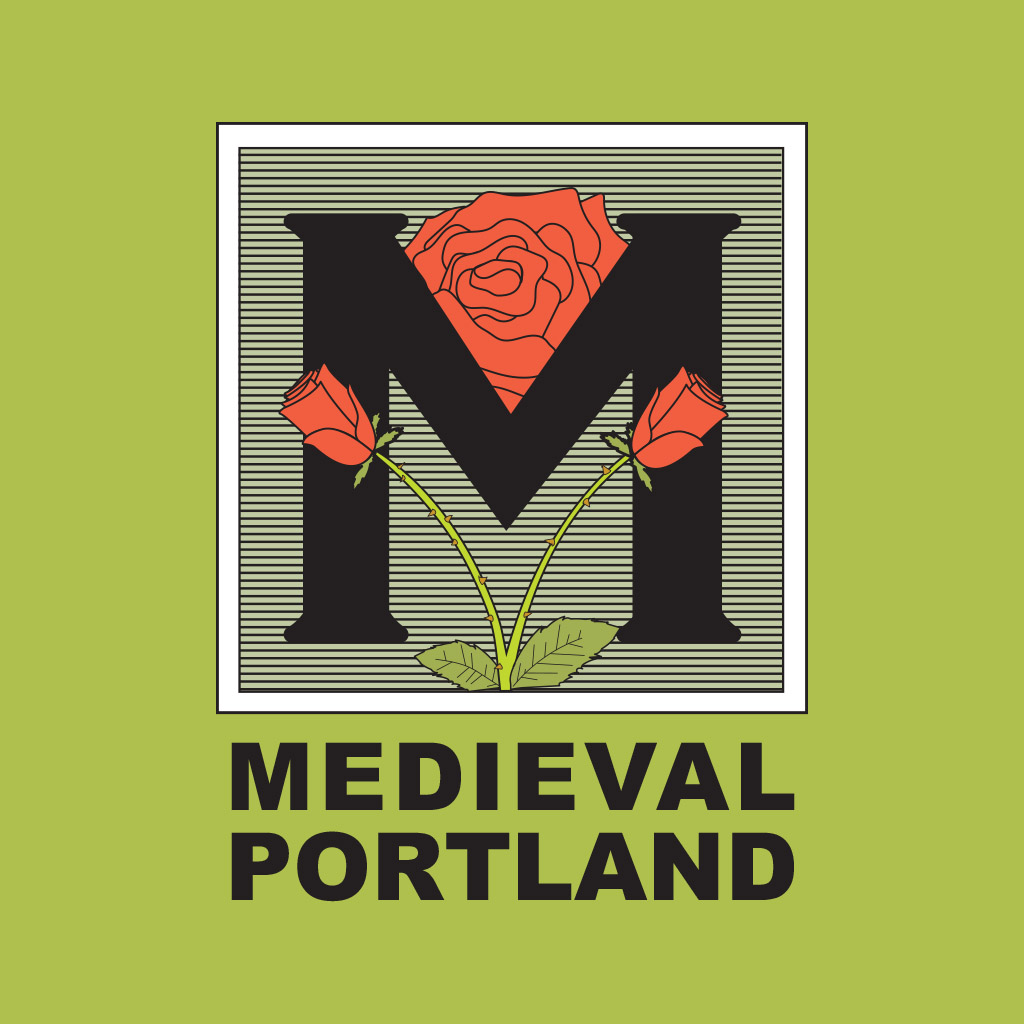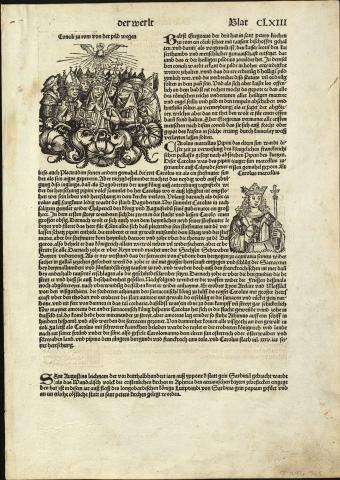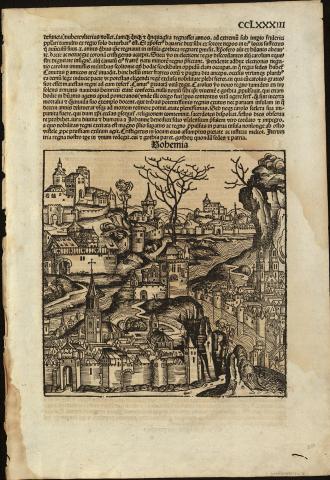Nuremberg Chronicle Leaf | Liber Chronicarum Leaf
1493
Leaf 163 (CLXIII), recto
Printed in Nuremberg, Germany
Language: German
height 44 cm | width 31 cm
Portland State University Library Special Collections Mss 24
Rose-Wright Manuscript Collection no. 16
Brad Blando, Medieval Portland Capstone Student, Winter 2005:
Portland State University Millar Library is home to two pages from the Liber Chronicarum, more commonly known as the Nuremberg Chronicles (Special Collections Mss. 23 and 24). These pages date from the year 1493 and are an excellent example of early printing from Nuremberg, Germany. Nuremberg at this time was an economic power in central Europe. The Chronicle was produced in two editions: a Latin version, which was published in July of 1493, and a German version, which was published in December of the same year. Mss. 24 is apparently written in early German, while Mss. 23 is written in Latin.
This particular leaf from the Latin version, page number CCLXXXIII of the text, has a large woodcut depicting a stylized image of the province of Bohemia. The reverse side of the page only has text. There are several references to provinces in Germany at the time, such as Bephrilia, Bohemia, Beholandia, Be Selandia, and Be Weftualia. Bohemia, which in modern times was known as the Czech Republic, had been influenced, occupied, or controlled by Germany in the past. Weftualia first appears as the name of the western third of the duchy of Saxony in the 10th century. The woodcut on the other side of this manuscript page, entitled " Bohemia," renders what appears to be multiple cities, each marked as distinct by the walls surrounding them.
Two wealthy Nuremberg merchants, who were brothers in law, commissioned the Liber Chronicarum. Their names were Sebald Schreyer and Sebastian Kammermaister. They contracted Michael Wohlgemut and his stepson Wilhelm Pleydenwurff to make the woodcuts for the book as well as to draw up layouts showing the setting of the type and the placement of the woodcuts. Hartman Schedel, a Nuremberg physician and humanist scholar, supplied the text. Schedel showed himself to be of the medieval scholastic tradition, compiling and excerpting texts from older sources. Building on the discovery of many classical texts by Renaissance scholars, Schedel adopted more than 90% of the entire Latin text directly from other sources. His only original contribution consists of compiling and editing the texts with occasional brief commentaries. The famous printer, Anton Koberger, the largest printer and publisher in Germany at the time, was employed to print the book. At the pinnacle of his career, Koberger ran 24 presses and employed over 100 artisans.
Each page of the Chronicle is designed as a double spread composed of 14 basic page layouts. Manuscript 24 represents a common arrangement with a vertical strip of woodcuts taking a quarter of the page and the text filling the other three-quarters. Notice how the type and the prints have a very similar texture. The woodcuts, by the nature of the process, have thick lines, which contrast with the white of the paper. The typeface used - based on the writing of scribes in manuscripts - also has strong contrast between thick and thin strokes. The prints and type are printed together on the press, since they both use the same relief printing technique (though the first is through woodcuts, and the latter through metal). The woodcuts shown in the chronicle represent the emergence of xylography as a prosperous industry in South Germany. First seen in China around the first century, wood engraving, or xylography, is the oldest known engraving technique. Xylography was quite dominant in Europe for several years before Gutenberg invented typography. The woodcuts normally presented biblical scenes, saints, and moralities. Illiterates of medieval Europe used the woodcuts as charms for protection. Xylography achieved prominence in South Germany following the publishing of the Nuremberg Chronicle. Albrecht Durer became a leader in the art of xylography and was a part of the distinguished group who created the woodcuts of the Chronicle.
The Nuremberg Chronicle continues in the tradition of medieval chronicles, which represent human history in six ages, from creation to 1493. The scope of the work includes the history of the Church, secular history, classical antiquity, and medieval and contemporary events mixed with a number of fables, myths, and legends. The Chronicle also covers important figures, such as the ones shown in manuscript 24. These included kings, clergy, as well as philosophers and other thinkers.
The book was intended to describe to a general but educated audience the history of the world up to the time of printing, in a number of accepted stages of time. It featured illustrations of biblical scenes, portraits, elaborate family trees where portraits of individuals are linked by vines, and views of famous European cities. The book also contained the first map of central Europe, as well as a map of the known world. While the text had a renaissance style, a medieval style was used for the illustrations. It was the most ambitious book-printing job undertaken since the invention of movable metal typesetting, only several decades earlier. The Nuremberg Chronicle receives much scholarly attention today. The fact that some 800 examples of the Latin edition and 400 of the German edition are still in existence testifies to the popularity of the Liber Chronicarum. In fact, it is estimated that around 1500 copies of the Latin edition and 1000 of the German edition were printed.
Suggestions for further reading:
Liber Chronicarum: A history of the world from Nuremberg, Germany, Christine J. Marshall, Taken from the Web. February 24, 2005.
The Print and the Book, Author Unknown, Taken from the Web. February 20, 2005.
Book of the Month, Nuremberg Chronicle, August 2003, Hugh Cahill, Taken from the Web. February 22, 2005.
The Nuremberg Chronicle, Michelle Muggridge, Taken from the Web. February 18, 2005.
The Nuremberg Chronicle, University of Maryland Library, Rare Book Collection, Taken from the Web. February 24, 2005.
STUDY GUIDE: Rachel R. Correll, Sophomore Inquiry Mentor Session Project, Winter 2012:
The Text
These leaves are from the Liber Chronicarum (commonly known as the Nuremberg Chronicle) by Dr. Hartmann Schedel (1440-1514), printed in 1493 in Nuremberg in present-day Bavaria. There were two editions of this printed book, one in Latin and one in German, the latter translated by George Alt. This was a very large project meant to be a chronicle of the world from the first days of creation to 1493. The end product was 600 pages with 1800 illustrations done in woodcut for each book. It is thought 1500 Latin books and 1000 German books were printed in all. As evidence of the importance of this large text, at the time of its printing, this was the most woodcuts used in a printed book, likely 645. Michael Wolgemut and Wilhelm Pleydenwurff were the woodblock artists while Anton Koberger was the printer. A lot of pre-planning was necessary for such a large project and there still exist exemplars for both the Latin and German versions of the Nuremberg Chronicle, complete with the handwritten text and sketches for the woodcuts.
The Scene
In the late fifteenth century, Nuremberg was enjoying the height of its medieval prosperity and had about 50,000 people. It was a city with extensive trade relations throughout Europe and humanism was a popular theory among many in the city, including Schedel. As a humanist, he believed his world chronicle should be available "for the common delight" and thus planned to have it translated into German simultaneous with its production in Latin. The text covers both religious and historical events, though Schedel seemed less interested in history and divides his chronicle into the six ages of man laid out by St. Augustine, the sixth being from Christ's birth to the Day of Judgment. This period of book printing before 1501 was at the heart of the transition from the medieval manuscript to the printed book and thus these books are referred to as incunabula. Chronicles were being written in Nuremberg in the first half of the fifteenth century, though Schedel's chronicle was the first real world history. The first printed world chronicle, the Fasciculus Temporum, was completed in 1474 and compiled by Werner Rolevinck. Like the Nuremberg Chronicle, the compiler created an exemplar of the layout of the entire work, doing all of it by hand.
The Objects
Mss. 23 in the PSU Special Collections is leaf 283 (CCLXXXIII) from the larger Latin 1493 printing of the Nuremberg Chronicle. On the recto of the leaf (the front) is some text with a city view of Bohemia while the verso (the back) is only text. There were fifty-three woodcuts of cities and countries that were used for all 101 different places illustrated throughout the chronicle. Thus this image of Bohemia is not meant to be an accurate depiction but rather a generic representation of the city.
Mss. 24 in the PSU Special Collections is leaf 163 (CLXIII) from the German 1493 printing of the Nuremberg Chronicle. On the recto of the leaf is some text with two woodcuts. The woodcut in the upper left is of councils to Rome on the image, which is stated in the caption to the woodcut. This is during the time of iconoclasm in which some opposed figural lifeless images of God, Christ, and the saints because they did not represent their true nature (e.g. paintings and statues). The scene here is likely of a synod, or council of the church, in 730 organized by Pope Gregory III in which iconoclasm was condemned. The woodcut was used for various other councils mentioned throughout the text and thus one can see here the deterioration of the woodcut as it had been used many times before. The other, smaller image is a portrait of Carolus Marcellus, or Charles Martel (686-741). The grandfather of Charlemagne, Charles Martel was a Bohemian, or Frankish, ruler that defeated the Muslims in the Battle of Tours in 732, effectively curbing their expansion into Western Europe. There were only ninety-six woodcuts of emperors, kings, and popes for the chronicle which were used 598 times and thus each represented multiple figures. On the verso of the leaf is text with three portraits from the line of popes. The three pictured, from top to bottom, are St. Zachary who was pope 741 to 752, Stephen II (752-757), and Paul I (757-767). St. Zachary was the last Byzantine pope, while Stephen II was more sympathetic to the Franks as was his brother, Paul I.
Inquiry
What groups and social classes do you think possibly had access to this book? How do you think it was received and used by each of these different groups? Look carefully at the woodcuts. Do they seem generic to you? What is the benefit of having the images in the text, even if they are not accurate? Inspect the woodcut of the council on page 163 recto and see if you can find where the woodblock has deteriorated and not produced a clean, complete image. Consider the text on the pages as well. How have they divided up the page so that it is easier to locate specific passages? If possible, hold up page 163 to the light. Can you locate and identify the watermark? (Hint: It should be a three-tipped crown.)
STUDY GUIDE: Rachel R. Correll, Sophomore Inquiry Mentor Session Project, Winter 2012:
Early Printed Book
In the western world, the printing press was first invented around 1450 by Johannes Gutenberg who also developed a system for movable type. Books printed before 1501 during this transitional phase from the handwritten manuscript or codex to the printed book are called incunabula.
Paper
The paper was handmade and laid to dry on a wire mesh. Lines are created in the paper when the wet pulp is laid on wires to dry, a time when the paper is more delicate and susceptible to markings. Each papermaker had their own watermark, a symbol such as a fish or a crown, which represented their business. These were imprinted into each sheet of paper in a similar method as the wire lines, using metal wires shaped into a design and set into the wire mesh on which the paper dried. Like the wire lines, the watermarks are usually found by holding the paper up to a light source. Each page in the book is called a leaf and each leaf has a front (the recto) and a back (the verso). This terminology is inherited from handwritten manuscripts and differs from today's pagination of books where the front and back of the pages are numbered separately. The leaves were usually half of a sheet of paper that was folded and gathered into signatures, another inheritance from manuscripts. Three sheets of paper would then be folded into twelve pages and two sheets into eight pages, creating signatures. The signatures were then gathered together in the proper order, sewn together, and then bound into covers, creating a book.
Images - Woodcuts
The artist made woodcuts by taking a block of wood and carving out the parts that were to be uncolored in the final image. The image needed to be carved as a mirror reflection of the desired result. The woodcut was then inked and pressed on the paper using the printing press so an impression of the uncarved parts of the wood would appear on the page, creating a relief-printed image. One woodcut could be used multiple times, simply by reinking.
Text - Movable Type
The printing was done with movable type which was also printed in relief like the woodcuts and thus text and image could easily be combined on a page. The letters were usually cut individually into metal in relief which were then organized together to forms the words set into lines. Once all the letters were laid out, they were inked, a piece of paper was laid upon them, and the printing press was used to press the ink into the paper. Because the letters were metal, they could be reused multiple times to print the same page. Two pages could be pressed at a time as each sheet of paper typically would represent the front and back of two leaves. In a signature of three sheets, the first and twelfth pages would be printed simultaneously."


